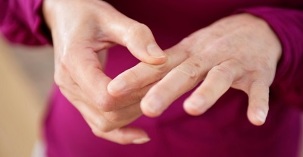
Painful sensations in the joints of the fingers can occur for various reasons. Every pathological condition requires competent treatment.
Joint diseases require an integrated approach. Includes the use of drugs, diet, physiotherapy, special gymnastics and alternative medicine.
Possible causes of finger joint pain
Joint pain can occur at any age. There are many possible reasons for this phenomenon.
Polyosteoarthritis
Pain in the joints of the fingers in 40% of cases is caused by this cause. This pathology is often called polyarthrosis or nodules of the fingers. It belongs to dystrophic diseases and is characterized by slow progression, which is why patients often ignore the first stage of the disease.
The disease most often affects people over 50 and is rare in people under 40.
The causes of polyosteoarthritis are often called heredity, but there are other factors that provoke it:
- culmination;
- violation of the exchange of materials;
- pathology of the thyroid gland and other endocrine glands;
- diabetes.
Joints contain cartilage that begins to break down. This means that the natural lubrication is disturbed, causing dryness and cracking.
Due to the lack of lubrication and drying, the articular cartilage rubs against each other, which provokes an inflammatory process. Against this background, an abnormal inflammatory joint fluid is produced, which expands the joints from the inside. As a result, their deformation occurs, accompanied by painful sensations.
Polyosteoarthritis is accompanied by other symptoms. They are represented mainly by Bouchard and Heberden nodes:
- Bouchard's nodesdevelop slowly, without complications. They usually form on the lateral surfaces of the joints, giving them a spindle shape.
- Heberden's nodesaffect the distal interphalangeal joints of their dorsal and lateral parts. They are characterized by symmetrical development of both hands. Knot formation is often accompanied by swelling and redness of the skin around the joints. Painful and burning sensations appear, although in 30% of cases the pathology is asymptomatic.
As polyosteoarthritis progresses, joint stiffness increases. The consequence of the pathology are nodules on the fingers.
Rheumatoid arthritis and Style's disease
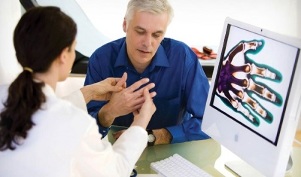
This disease belongs to systemic connective tissue pathologies and has a complex autoimmune pathogenesis. The pathology rarely occurs in patients under 30 years of age. It is 5 times less common in men.
The signs of rheumatoid arthritis depend on its stage:
- The initial stage of the disease is characterized by periarticular swelling of the bursae. This leads to pain, swelling of the periarticular area and a local increase in temperature.
- In the second stage, the cells begin to divide rapidly, as a result of which the synovium becomes denser.
- In the third stage, the inflamed cells produce an enzyme that affects both cartilage and bone, so the affected joints usually deform. This stage is accompanied by increased pain and loss of motor function.
There are three groups of possible causes of rheumatoid arthritis:
- Heredity.
- Infections. Pathological changes can be caused by some paramyxoviruses, herpes viruses, hepatoviruses, retroviruses.
- Triggers. Pathological changes can be caused by hypothermia, intoxication, stress, taking certain drugs, hyperinsolation, endocrinopathy.
Still's disease is a form of rheumatoid arthritis. It is usually accompanied by fever, rash and itching. This disease is more commonly diagnosed in children. In addition to the joints, Still's disease can affect the lymph nodes, provoke pleurisy, pericarditis.
Psoriatic arthritis
This pathology is one of the forms of arthritis and can appear after 20 years. It develops against the background of psoriasis, but in some cases precedes it.
In addition to the painful sensations, the pathology is accompanied by the following signs:
- swelling of the joints;
- the acquisition of bluish-purple skin in the periarticular area;
- the appearance of bumps and dents on the nails;
- slight stiffness.
There is a destructive form of pathology characterized by rapid bone erosion. This is fraught with loss of joint mobility.
The inflammatory process can affect not only the joints but also some organs. The skin plaques characteristic of psoriasis in this form of arthritis are often accompanied by the appearance of acne.
Possible causes of psoriatic arthritis are as follows:
- alcohol abuse;
- smoking;
- stress;
- skin damage;
- side effects of some drugs;
- changes in hormone levels;
- excess ultraviolet radiation.
Infectious arthritis
This type of arthritis is also called septic and is characterized by an inflammatory process caused by bacteria, viruses, fungi or parasites.
There are many possible symptoms of pathology - the clinical picture depends on the cause of the infection.
The main signs of the disease are:
- soreness;
- mobility restriction;
- hyperemia of the affected area;
- swelling.
As the cause of the pathology is an infection, it may be accompanied by fever, chills and intoxication syndrome.
Infectious arthritis can develop against the background of another disease - rheumatoid arthritis, osteoarthritis, diabetes, obesity. The reason may be alcohol and drug addiction, a sexually transmitted infection.
Gout
This pathology is also called gouty arthritis. It is a metabolic disease. In this case, uric acid or sodium monourate is deposited in the tissues of the body. Gout is much less common among women.
The pathology is characterized by a paroxysmal nature. Episodes of exacerbation can last from 3 days to a week and a half. The attacks are characterized by a sharp appearance and the same quick stop. The presence of seizures means an inflammatory process.
Exacerbation of the disease often begins at night and may be accompanied by the following symptoms:
- pain worse when moving;
- the skin above the inflamed joint turns red;
- body temperature rises;
- lesions are usually unilateral.
In addition to the acute period, there are latent and chronic stages of pathology. In the first case, the course of the disease is asymptomatic and its only sign is hyperuricemia (an indicator of a blood test). The chronic stage is characterized by long periods of remission.
Rizarthrosis
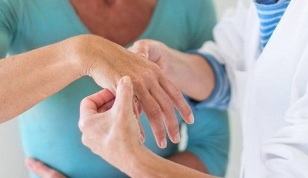
This pathology is a form of osteoarthritis in which only the thumb is affected. In most cases, rhizarthrosis is a manifestation of polyosteoarthritis, but every 4-5 patients is an independent disease.
In every second person, this pathology is caused by trauma. It can be a household or a sport.
There are other causes for the pathology:
- incomplete rehabilitation in case of fracture of the wrist bone;
- permanent minor injuries to the joint capsule;
- heredity; joint dysplasia;
- disorders of the endocrine system;
- metabolic disorder;
- The effects of some drugs that cause changes in cartilage tissue.
There are 3 stages of pathology:
- At first, one feels only discomfort.
- Then bone growths appear and the painful sensations intensify due to the exposure of the nerve endings.
- In the last stage, the thumb is severely deformed and its mobility can be completely lost.
Pain is the main symptom of the disease. It increases with movement, drop in atmospheric pressure, under cold or hot water. At first the pain hurts, and in the last stage of the pathology it becomes simply unbearable.
De Querven's disease (tenosynovitis)
In this case, only the thumb ligaments become inflamed. This pathology is provoked by constant and monotonous movements of the hands, which causes slight damage to the tendon that runs along the back of the wrist. Trauma can be another cause of the disease.
The disease is often a companion of people from certain professions:
- musicians;
- seamstresses;
- artists;
- athletes (tennis players, skiers);
- masons;
- typing.
This pathology can develop at any age. Painful sensations with it can occur spontaneously, but more often they are provoked by the load on the thumb - by pressing, stretching, trying to grab an object.
Stenotic ligamentitis
This condition is also called Knott's disease or snap fingers. The cause is inflammation of the tendon and the formation of nodules on it.
In this case, the affected finger bends and returns to its original position.
Painful sensations occur when the finger is bent and stretched. In addition to pain, other symptoms are characteristic of the disease:
- tingling;
- hypersensitivity;
- swelling of the joints;
- lump formation.
Stenotic ligamentitis can be caused by rheumatoid arthritis, diabetes and high stress on the joints.
Risk factors
In each pathology there are several possible reasons for its development. There are also a number of risk factors that make finger joints more likely to develop:
- hereditary predisposition;
- chronic infection;
- diseases of the immune system;
- pathology of material exchange;
- altered hormonal background;
- trauma and microtrauma;
- long-term negative impact.
Diagnostics
When painful sensations first appear in the joints of the fingers, they usually turn to a therapist who prescribes initial examinations and turns to a narrower specialist - surgeon, neurologist, traumatologist, arthrologist, rheumatologist, orthopedist, reflexologist, osteopath, endocrinologist, nutritionist, phthisiologist.
In any case, the diagnosis begins with a visual inspection. After that, the specialist prescribes standard laboratory tests of blood and urine. They allow you to identify the inflammatory process in the body and evaluate some important indicators (albumin, globulin fractions, the amount of iron).
Joint puncture belongs to laboratory methods. A synovial fluid collection needle is inserted into its cavity. This test is also called arthrocentesis.
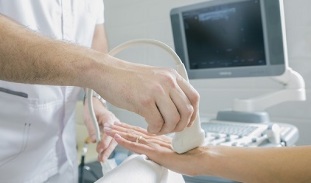
Of the instrumental diagnostic methods, the following tests may be performed, depending on the circumstances:
- x-ray.This method allows you to identify trauma, fracture, tumor and other bone damage.
- Ultrasound scan.This technique is used to examine soft tissues. In addition, using ultrasound, you can check the condition of the vessels.
- Tomography- computer, magnetic resonance imaging. CT is preferably used to examine bone structures - the test is similar to an X-ray, but much more informative. MRI is more effective in examining soft tissues
- Scintigraphy.This test is performed using a radio indicator.
- Electrocardiogram.Such a diagnosis allows you to check whether the pathology has affected the heart.
Treatment of pain in the fingers of the joints of the hands
Every disease requires certain measures. The basis of treatment in most cases is drug therapy in combination with physiotherapy and special gymnastics. Some diseases require a special diet. Folk recipes can also be effective in the treatment of joint pathologies.
Drug therapy
Different drugs are the basis for the treatment of most diseases.
The following drugs are used for joint damage:
- Non-steroidal anti-inflammatory drugs.Such funds are used for various inflammatory processes. They not only reduce inflammation, but also reduce pain and fever. Such drugs are produced in various dosage forms - for topical administration, oral administration, injection.
- Antibiotics.Such drugs are used in the inflammatory process, as well as in the infectious origin of the pathology. For the appointment of antibiotic therapy, the cause of the disease is first identified to determine its sensitivity to the drug.
- Glucocorticosteroids.These drugs are steroidal and anti-inflammatory. Their action accelerates the recovery process. They are also available in various dosage forms.
- Chondroprotectors.These drugs are used as part of a comprehensive treatment. They accelerate the recovery process, prevent the recurrence of pathology.
- Analgesicscan be used for severe pain that cannot be tolerated. These can be either topical medicines in the form of a cream or gel, or medicines for oral administration or injections.
- Immunosuppressants.Such drugs are used when the pathology is of an autoimmune nature.
The medicine should only be prescribed by a doctor. Each patient needs an individual approach, therefore, even with the same diseases in different people, the set of necessary drugs can be radically different.
Traditional medicine
Alternative medicine is used in the treatment of various diseases, including those affecting the joints.
The following folk recipes can be effective:
- Melt the propolis and mix it with vegetable oil - more suitable is sunflower or corn oil. The resulting composition should be used as an ointment, rubbing into the affected areas.
- Rubbing with honey and horseradish. The products must be mixed in equal proportions.
- Dissolve a spoonful of mustard powder in half a glass of vodka and massage the affected areas with this composition.
- Boil unpeeled potatoes, knead and apply warm compresses on the inflamed areas.
- Grind the onion to a pulp and apply a compress on the affected areas. You should keep it for half an hour, repeating the procedure up to three times a day.
- The tincture of lilac flowers helps a lot. You need to fill 3 tablespoons raw with a glass of vodka and leave for a week in the dark. Rub the affected areas every day with a strained mixture for at least half a month.
- Boil the rolled oats so that it acquires the consistency of jelly, cool slightly, soak a bandage in it and apply on the affected areas, fixing it with polyethylene. Remove the compress after an hour.
- In case of inflammation, dissolve 1 teaspoon of baking soda in milk and drink.
- If the inflammatory process worsens, then you can apply fresh cabbage, smeared with honey, on the affected area.
- Limbs with affected joints can be kept in a bath with the addition of birch broth.
- Heat salt or buckwheat in a pan, place in a cloth bag and attach to the affected area, leaving for a few hours.
- It is useful to use an infusion of bay leaf inside. To do this, pour a glass of boiling water on several leaves and insist.
- Black radish juice with honey is useful. You should take one tablespoon of this medicine three times a day.
- The juice is useful in joint pathologies. A glass of cranberry or cranberry juice, birch sap is enough a day.
Only traditional medicine is appropriate in the initial stage of pathology development. In other cases it should be used in combination with traditional methods. Self-medication may not work and the pathology will only get worse during this time.
Physiotherapy
Physiotherapy is one of the components of the overall approach to joint pathologies. It is performed only on the advice of a doctor. There are many methods of physiotherapy, so the appropriate option is chosen individually.
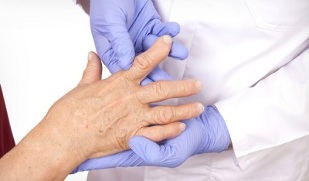
The following procedures are suitable for various pathologies of the finger joints:
- magnetic therapy - constant, pulsed;
- electrophoresis; UHF;
- laser therapy;
- phonophoresis; ozokerite therapy; cryotherapy;
- galvanized;
- diadynamic therapy;
- oxygen therapy;
- balneotherapy;
- shock wave therapy;
- ozone therapy.
Various therapeutic methods are designed to restore joint mobility, restore blood circulation, muscle tone, improve the metabolic process and accelerate recovery.
Each method of physiotherapy has certain contraindications, so it is worth resorting to them only as prescribed by a doctor.
Finger Gymnastics
Special finger exercises are part of a holistic approach to treatment. Such gymnastics allows you to restore blood circulation and mobility, reduce pain and has a general strengthening effect.
Before gymnastics you can warm your hands if there are no contraindications. It is enough to immerse your hands in warm water for 5 minutes or apply a heating pad on them.
The following exercises are effective in various joint pathologies:
- Fists clench and loosen. You should squeeze your hand lightly into a fist so that your thumb is on top of the others. In this position you need to hold for 0, 5-1 minute, then relax your fist, spreading your fingers as much as possible. You should do at least 4 reps for each hand.
- Warming up with your fingers. You need to place your palm on a hard surface and press it firmly. Alternatively, lift each finger up, doing 10 reps for each hand.
- Contact. You should turn the palm of the hand towards you and connect the tips of each finger with the tip of the thumb, forming a circle. Each contact should be held for 0, 5-1 minute. Do 4 or more reps for each hand.
- Exercise with your finger. The palm should be on a hard surface. You need to move your thumb on it, keeping it as far away from the others as possible. At the end point you need to hold for 0, 5-1 minute, then return to starting position. Do 10-15 reps for each hand. Do the exercise every 2-3 days.
- There is another thumb exercise. You should turn your hand with the palm facing you, move your thumb as much as possible, and then bend it so that its tip touches the base of the little finger. At this point you need to hold for 0, 5-1 minute. Do 4 or more repetitions by hand.
- Stretching with a brush. You need to put your palm on the table and straighten the brush so that it becomes as flat as possible. In this position you should stay 0, 5-1 minute. Do 4 reps for each hand.
- Stretch your fingers. You should turn your hand with your palm towards you and bend your fingers so that they touch the skin of your bases. In this position you need to hold for 0, 5-1 minutes, then gently straighten your fingers. Do 4 or more repetitions by hand.
- Stretching the thumb. You should turn your hand with your palm towards you and bend your thumb so that its tip touches the base of the index finger. In this position you need to hold for 0, 5-1 minute, do 4 repetitions.
- There is another option for stretching the thumb. The starting position is the same. The thumb should be pulled to the base of the little finger, moving only the lower joint. At the end point, hold for 0, 5-1 minute, do 4 repetitions for each hand.
- Strengthening exercise. You need to take a soft ball and squeeze it as much as possible, holding on to the end point for a few seconds. Do 10-15 reps for each hand. The exercise itself should be done not every day, but every 2-3 days, resting on your hands.
- Clips. This exercise also requires a soft ball. It should be pinched so that there is a thumb on one side and everyone else on the other. In this position you need to hold for 0, 5-1 minute. You should do 10-15 reps for each hand. Exercise every 2-3 days.
In addition to such exercises, it is useful to work with clay or plasticine. The material can simply be rolled and kneaded or various crafts can be made.
Finger exercises should not be done when the pain is too intense. In this case, exercise can only hurt.
Diet
One of the principles of treatment of various joint pathologies is proper nutrition.
The diet should be organized according to the following principles:
- Normalize weight. This is necessary for deviations in each direction. In the case of disorders of fat metabolism, lipids are deposited on the joints.
- Salt limit. If there is too much of it in the body, then the joints lose elasticity.
- Avoid alcohol.
- In gout, the emphasis should be on plant foods to alkalize the body.
- Reduce your intake of animal protein. The amino acids contained in it penetrate the synovium, provoking inflammation and pain.
- It is better to refuse meat broths or use secondary broths.
- It is better to use meat not in pure form, but as cutlets, meatballs, meatballs.
- For gout you should give up oily fish, caviar, cod liver, offal, eggs, butter on cream, oily sour cream, nuts.
- You should refuse pastries, confectionery, cereals after pre-processing, immediate products.
- The diet should be rich in vitamin C. For this you need citrus fruits, blueberries, apples, peppers, black currants, Brussels sprouts, broccoli.
Prevention
Any disease is easier to prevent than to cure. The following measures are suitable for the prevention of various joint lesions of the fingers:
- Proper nutrition. The diet should be rich in fresh fruits and vegetables, complex carbohydrates, lean protein foods and unsaturated fatty acids.
- Adequate intake of vitamins and minerals. If there are not enough of them in the diet, then you should resort to funds from the pharmacy.
- Proper drinking regimen. Lack of fluid slows down the metabolism, which disrupts blood circulation and nutrition of the joints and reduces the volume of synovial fluid in them. The drinking regime should be based on clean water without gas. On average, you should drink 2 liters of fluid a day.
- No bad habits.
- Adequate physical activity. It is important for the normal speed of metabolic processes in the body, good blood circulation, strengthening of periarticular muscles and ligaments.
- Special gymnastics for fingers. It is especially important when the fingers are under constant stress. This is true for some athletes and professions.
- Competent alternation of activity and rest. The night's sleep must be complete.
- Minimal stress.
- Regular medical examinations. They can detect the initial stage of the pathology or the prerequisites for its development, which allows you to take the necessary measures in a timely manner.
Pain in the joints of the fingers cannot be ignored. Even in the absence of concomitant symptoms, such a phenomenon may be the first sign of serious pathology. An integrated approach is used in the treatment of joint diseases. Therapeutic methods should be prescribed by a physician, as each patient needs an individual approach.

























